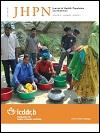National Scale-up of Zinc Promotion in Nepal: Results from a Post-project Population-based Survey
DOI:
https://doi.org/10.3329/jhpn.v29i3.7868Keywords:
Child health, Diarrhoea, Infantile, Knowledge, attitudes, and practices, Oral rehydration solutions, Oral rehydration therapy, Zinc, NepalAbstract
The World Health Organization and the United Nations Children’s Fund recommend using a new oral rehydration solution (ORS) plus zinc supplementation for 10-14 days for the treatment of diarrhoea in children aged less than five years. The Social Marketing Plus for Diarrhoeal Disease Control: Point of Use Water Disinfection and Zinc Treatment (POUZN) project in Nepal was one of the first zinc-promotion projects to move beyond pilot efforts into a scaled-up programme with national-level reach. This study used data from a survey conducted in 26 districts in Nepal in 2008 to examine zinc-use behaviour, knowledge, and beliefs of caregivers of children aged less than six years, other diarrhoea-treatment practices, and recollection of project communication messages. The results of the survey indicated that, by six months following the onset of a zinc-promotion campaign, the majority (67.5%) of children (n=289), aged less than six years, with diarrhoea were treated with ORS, and 15.4% were treated with zinc. Over half (53.1%) of all caregivers (n=3,550) interviewed had heard about zinc products; most (97.1%) of those who had heard of zinc knew that zinc should be used for the treatment of diarrhoea. Zinc-related knowledge and behaviours were positively associated with recall of communication messages. Children whose caregivers recalled the mass-media message that zinc should be used for 10 days [odds ratio (OR)=2.02, 95% confidence interval (CI) 1.85-2.19] and whose caregivers perceived that zinc is easy to obtain (OR=1.76, 95% CI 1.49-2.09) were more likely to be treated with zinc for 10 days, along with ORS. The findings demonstrated that mass media play an important role in increasing caregivers’ knowledge about zinc and encouraging trial and correct use. Future efforts should also focus on understanding the factors that motivate providers to continue recommending antibiotics and antidiarrhoeals instead of zinc. These findings are being used for informing the design and implementation of zinc programmes in other developing countries with a high prevalence of diarrhoea.
Key words: Child health; Diarrhoea; Diarrhoea, Infantile; Knowledge, attitudes, and practices; Oral rehydration solutions; Oral rehydration therapy; Zinc; Nepal
DOI: http://dx.doi.org/10.3329/jhpn.v29i3.7868
J HEALTH POPUL NUTR 2011 Jun;29(3):207-217
Downloads
256
216

